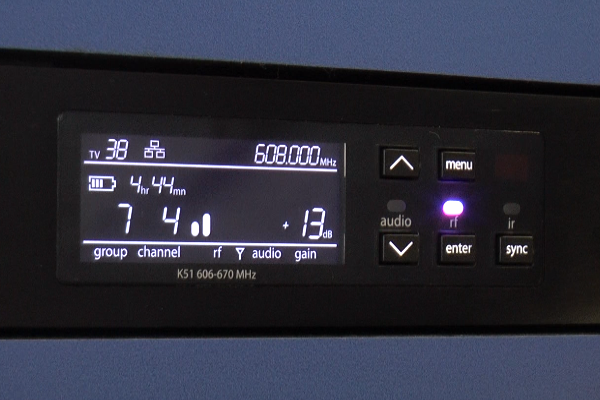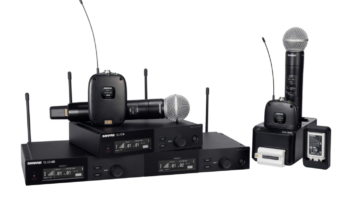
Paddy Baker recently visited the offices of Shure Distribution UK to be shown the company’s digital QLX-D mid-tier wireless microphone system, which has been designed with today’s RF spectrum conditions in mind.
The UHF spectrum works well for transmitting and receiving wireless microphone signals. However, as you move up into the gigahertz range of the spectrum, the wavelength becomes shorter thus the propagation is not as favourable and signal transmission becomes much less efficient.
However, it’s not only wireless mics that find UHF useful. When terrestrial TV broadcasting was switched off a few years ago, national governments sold off the relevant parts of the spectrum to the highest bidder. Predominantly it went to mobile phone companies, which use it for 3G and 4G data transmission.
Wireless microphone usage is constantly increasing – particularly, says Shure Distribution UK sales and project engineer Stuart Stephens, in schools, churches and in corporate applications – but with an ever-narrowing band of spectrum in which to operate. This inevitably means that the likelihood of interference from other sources increases, and the need for proper frequency planning and deployment becomes increasingly important. Additionally and more importantly, as spectrum becomes a diminishing resource, wireless microphones need to make more efficient use of it.
Shure recognised that the ongoing changes to the UHF band would create a harsh environment in which to operate wireless microphones. Extensive R&D was conducted into the development of spectrum efficient wireless products to suit a wide breadth of price points and applications. The most technology rich is Axient, which has been heralded as the most advanced radio microphone system currently available on the market in both design and performance. In the last few years Shure has launched a succession of new wireless products featuring technology first seen in Axient from radio microphones to IEMs, such as ULX-D, QLX-D and PSM1000.
Shure’s digital QLX-D wireless system, which the company launched at PLASA last year and showed at ISE 2015 last month, is a mid-tier product, developed from the higher-level ULX-D wireless system. “Traditionally, the best analogue systems on the market could operate between eight and 12 microphones in a single 8MHz TV band in ideal conditions. With QLX-D, we can fit up to 22,” explains Duncan Savage, head of the systems group at SDUK. “Additionally, with a tuning band of up to 72MHz, the user can cover nine TV bands in a single product SKU which also affords more efficient inventory management.” This means that QLX-D can operate more channels in a 8Mhz than any other system in its class.
Audio quality is 24-bit, with a ‘virtually flat’ frequency response. AES-256 encryption can be easily enabled for environments where secure transmission is important.
A major strength of QLX-D is its network capability. Shure’s Wireless Workbench software – available for Windows and Mac – enables control and monitoring of the whole system. Users can monitor RF levels and audio levels throughout an installation, or just in a single room.
Savage adds: “You can also use Wireless Workbench to deploy co-ordinated frequencies to every receiver on a network at the push of button.”
One feature of particular interest to the installation community is that networkability also extends to the system being compatible with other control systems, such as Crestron, AMX and other third party control platforms.
Transmitters are handhelds, available with a selection of interchangeable Shure capsules, or bodypacks. These are sturdily built, with an anodised metal casing. Pairing them with a receiver is straightforward: the receiver performs a complete channel or group scan and allocates a frequency, and this is synchronised to the transmitter over IR at the press of a button.
The QLX-D transmitters use Shure proprietary rechargeable lithium-ion batteries, which have up to a 10-hour life, or standard AAs. When using Shure rechargeable batteries, remaining battery life, accurate to 15 minutes, is displayed on the transmitters and receivers. Wireless Workbench can also display audio and RF meters, battery life, and volume control for each channel of the system.
Savage believes that, despite efforts of industry bodies such as BEIRG to publicise the issues around spectrum sell-off, there is still a lack of understanding in some parts of the market. “Personal experience of RF difficulties tends to drive knowledge and the most aware are generally the people who’ve been bitten by spectrum issues already.”
Shure recently launched the Losing Your Voice website to highlight the issues around loss of spectrum for wireless microphones, and to provide information about the latest spectrum developments in the UK.
www.shure.eu
www.shure.co.uk
www.losingyourvoice.co.uk







